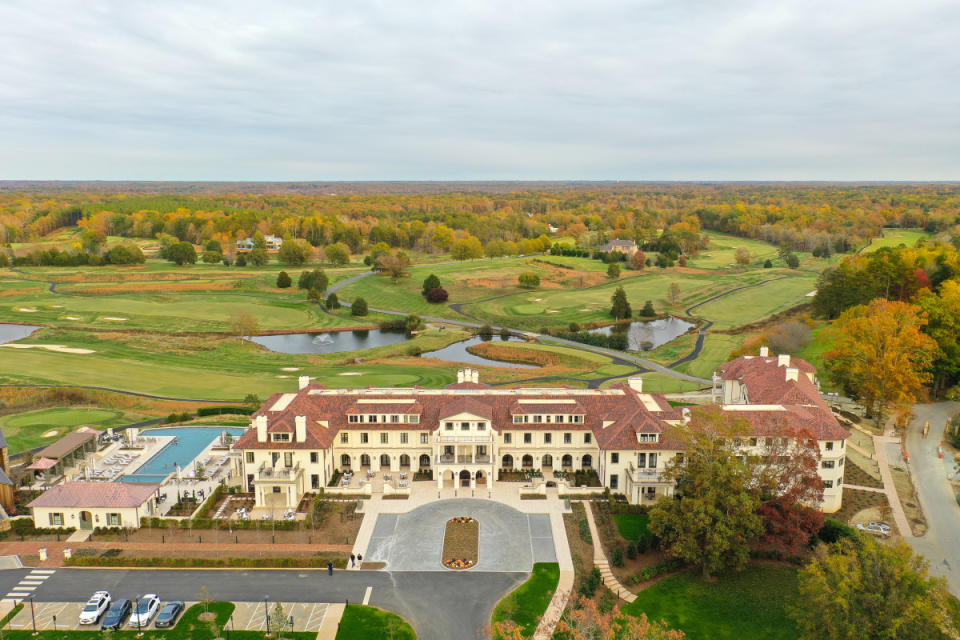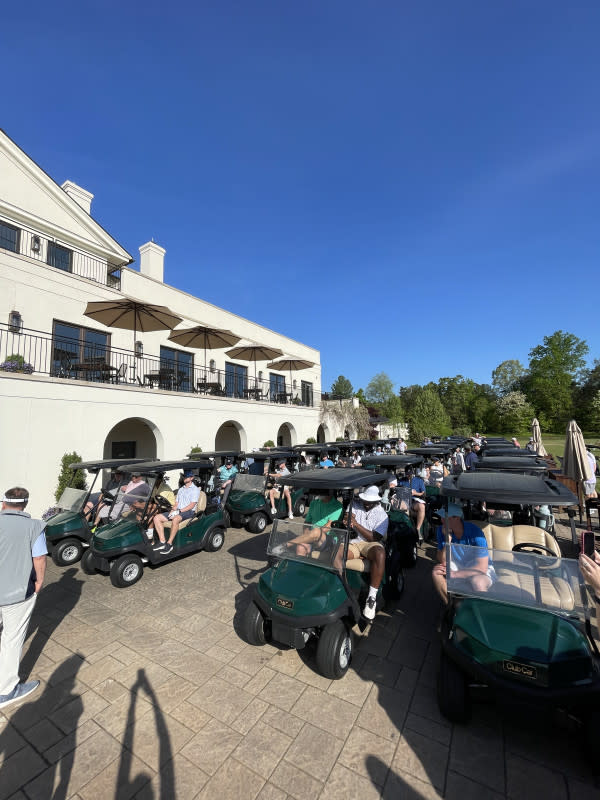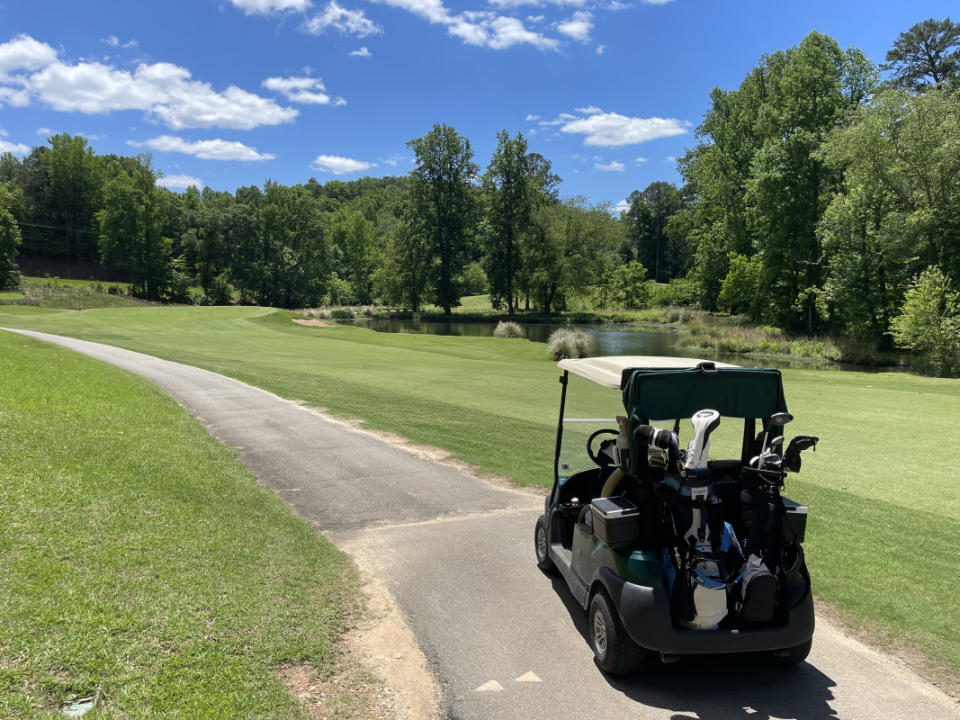Uncorking a Tee Time at the Intersection of Wine and Golf
- Oops!Something went wrong.Please try again later.
The wine industry overlapping with professional sports is certainly not a new phenomenon – basketball star, Dwyane Wade, for example, has his Wade Cellars wine label, and any Atlanta Braves baseball fans will remember that the 2021 World Series champion team had a “Burgundy Boys” wine club. Wine and golf, however, both offer a similar unique sense of community and camaraderie, and just like some of the most prestigious and well-known golf courses, prominent winegrowing regions are located in some of the most beautiful places in the world. This presents an incredible opportunity for the wine industry to capitalize more strategically on similarities with the golf industry (and vice versa) to bring a fresh, new perspective–and potentially even attract new audiences–to the enjoyment and tourism of both at the same time…and it’s exciting.

Courtesy of Keswick Hall
Take Charlottesville, Virginia, for instance, home of the Monticello American Viticulture Area’s breathtaking scenery and world-class vineyards named the Wine Region of the Year by Wine Enthusiast in 2023. The Monticello Wine Trail included a “Winemakers’ Golf Tournament” as part of their Monticello Wine Week celebrations. Charlottesville’s luxury Forbes Five-Star resort, Keswick Hall, hosted this day-long tournament on Keswick Hall’s Pete Dye-designed 18-hole Full-Cry golf course allowing guests to play alongside winemakers and fellow wine enthusiasts all while honoring the region’s achievement of global recognition in the world of winemaking. While overlooking the Blue Ridge Mountains about 15 minutes away from Thomas Jefferson’s Monticello, the University of Virginia, and an abundance of award-winning wineries, golf tournament participants were able to mingle with winemakers who are shaping a region that is so deeply rooted in a sense of place. It’s this type of intentional combination of the two industries that inspires further exploration for how wine professionals, golf courses, resorts, and tourists in general can benefit from the natural synergies between the two worlds.

Courtesy of Keswick Hall
For a deeper dive into what lies at the center of the golf and wine Venn diagram, let’s examine some similarities from the perspective of those who love playing golf but also work in the wine industry. In terms of skill development, for example, wine professionals agree that they both take time and practice. Jade Palmer, the Wine Buyer at Hop City Krog Street Market in Atlanta, Georgia, recalled how learning about wine and golf both required learning a whole new vocabulary. “Before learning to play golf, I didn’t know what ‘lie’ or ‘swing plane’ meant,” Palmer says, “and before learning about wine, I had no idea what ‘appellation” or ‘terroir’ meant, but now I use those words all the time.”
Similarly, Eric Palmer, a Fine Wine Specialist for Republic National Distributing Company, read a lot of performance psychology books from authors with backgrounds in golf, like Bob Rotella, when preparing to compete in the International Chaîne des Rôtisseurs Jeunes Sommeliers Competition last year. “Learning to forget previous shots and focus only on the shot ahead of me when out playing a round translates directly into blind tasting, where I need to let go of judgements or conclusions about a prior wine when assessing the next.” For wine professionals who are preparing for certifications, exams, or competitions, Eric Palmer also highlights how focusing on the minute mechanics during a service or blind tasting portion of a wine exam - like he often does while playing golf regarding swing mechanics on the tee box - allows for more grace and fluidity in performance.
And Lindsey Fragalle, a Sales Representative for Bon Vin Selections, articulates possibly one of the most common threads between the two skillsets recognizing that most wine people and golf people are extremely passionate when it comes to learning. “When you're just starting out in both, I think it's really easy to get overwhelmed with all of the resources available,” she says, “and once you've been bitten by the bug, it's hard not to go all-in and obsess over perfection, but let's not forget that both wine and golf should be fun! Sometimes we just need to remember not to take it all so seriously.” It’s this continuous learning and endless pursuit of knowledge, perhaps, that most greatly ties the art of these two skillsets together – and potentially makes them alluring to the same audience.

Courtesy of Keswick Hall
While wine and golf may have some similar barriers to entry, the combination of the two offers an interesting avenue for introducing their respective audiences to the enjoyment of the other. Sam Coturri, proprietor of Winery Sixteen 600 in Sonoma, California, has been thinking a lot about the evolution of modern wine tourism given his role of welcoming guests from all over the world to experience California’s wine country. He says that people traveling to wine regions are looking for things to do in addition to wine tastings, and they often want to be outside and active. Especially with golf courses and wineries in the same region, golf can be the recreational activity tourists are looking for with, what Coturri says, the bonus that wine can be included in the golf experience.
From a retail perspective, Jade Palmer of Hop City agrees. She points out that golf clubhouses often have an on-site restaurant with drinks available, so partnering with smaller production wineries (or even the local wineries within the winegrowing regions) and offering their wines instead of larger commercial brands could be a great way to connect golf enthusiasts with great wine. There’s even an opportunity for travel agencies and tourism bureaus to promote experiences that feature winery and/or vineyard tours along with tee times at local golf courses. Coming from a long family history in grape farming and wine production, Coturri says golf is one of the best ways to go out and actually experience a region’s climate, topography, and environment that a wine is expressing. “Did a winemaker tell you that morning fog slows ripening in the hot summer months?” Coturri wonders thoughtfully, “then play an early morning round and watch the fog give way to a warm sunny day.” He adds, “did a sommelier talk about a diurnal shift setting flavors? Then book a twilight tee time and feel the chill in the air as the sun dips in the sky.”
Eric Palmer has already been using this logic while thinking about his 2025 travel plans, and he’s thinking an awesome week could be had in Australia playing some of the legendary courses on the Melbourne Sandbelt, such as the National or Royal Melbourne West, while also learning about Australian wine. “The city is surrounded by wine regions all only a few hours away,” he says, “and I'd be keen on visiting Yarra Valley and the Mornington Peninsula to try some of the cool-climate Pinot Noirs.” Alternatively, he adds that there are some beautiful courses surrounding Sydney, which is only two hours away from the iconic Hunter Valley, Australia’s oldest wine region. “The Lakes, Long Reef, and New South Wales would be top of the list to play here,” he says, “and in either case, a dinner at Rockpool Bar and Grill (which has locations in Sydney, Melbourne, and Perth) would be a necessity, to drink through some of their colossal wine list, which boasts one of the largest collection of Australian wines anywhere.”
For a weekend trip in the U.S., though, he recommends the Cloisters at Sea Island in Georgia, which is home to three championship courses and a world-class wine cellar with over 1,000 labels. Encouraging these types of adventures for both wine and golf enthusiasts certainly is a promising way to strategize going forward.

Photo by Kelly Cornett
While plenty of synergistic qualities tie wine and golf together conveniently, one of the challenges consumption-wise for wine on the golf course is accessibility – people may think that wine belongs best on a dinner table or at least requires appropriate glassware to enjoy. But Coturri of Winery Sixteen 600 is confident that putting wine in cans is a promising way to overcome those accessibility hurdles on the course. “If golf clubs want to continue growing the game and reaching more demographics, they should grow the range of beverages they serve,” says Coturri. Not only does a 250mL slim can of wine fit extremely well in a golf bag, but the quality of canned wine is also improving exponentially. Winery Sixteen 600, for example, cans a rosé sourced from 30-year-old, own-rooted Primitivo vines at Cannard Family Farm in Kenwood, CA.
Jason Wilfore, Sommelier at Michelin One-Starred Mujo in Atlanta, GA, supports this call to action for golf courses to consider adding more canned wine as part of their on-premise offerings. Given his role as a sommelier, he is well aware of the fact that everyone's tastes are different, but he also thinks that packaging wine in a way that allows for people to more easily enjoy it on the golf course would be a relatively easy way to transition people into choosing wine instead of beer or canned spirits if they would prefer to do so during a round. “Spain has been making quality wines and releasing them in various sized cans for years,” he says, “and when you think about what to drink on the golf course, loading that little cooler up on the back of the golf cart with 8-ounce cans of wine seems like a pretty good strategy.”

Photo by Kelly Cornett
The intentional intersection of the golf and wine industries is offering promising tourism opportunities for both audiences, especially when golf courses and wineries are located relatively close to one another in the same region. And the Monticello Wine Trail in Virginia has already executed a successful proof of concept for incorporating a golf tournament at Keswick Hall in a wine-related event as a way for guests to interact with the region’s winemakers and celebrate all that the region has to offer. The entry points outlined by these featured wine professionals can and should be explored to their full potential, and the possibilities of intentional collaboration are abundant. The center of this particular Venn diagram is one to watch, so here’s a cheers to everyone thinking about adding a wine and golf trip to their calendars in the future.

